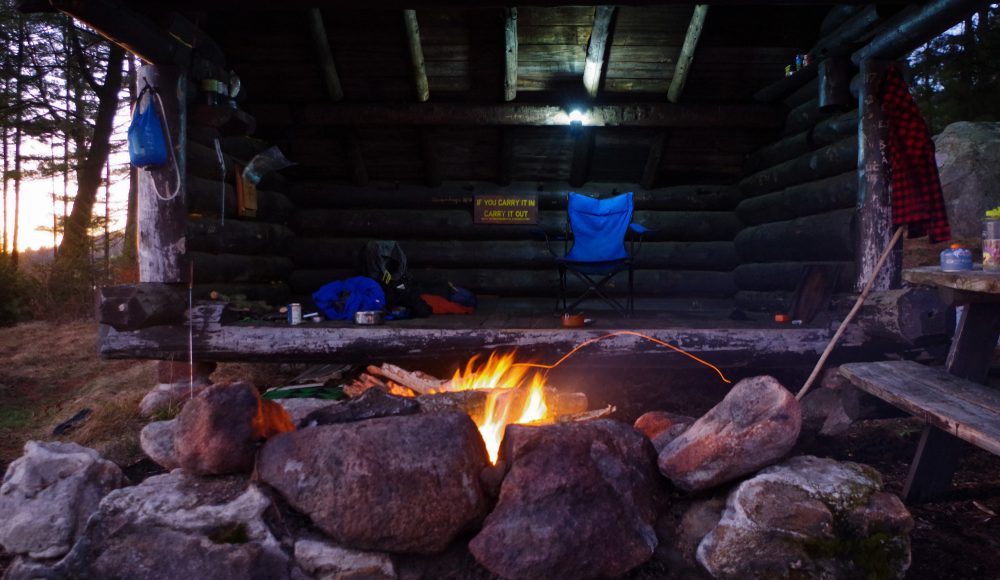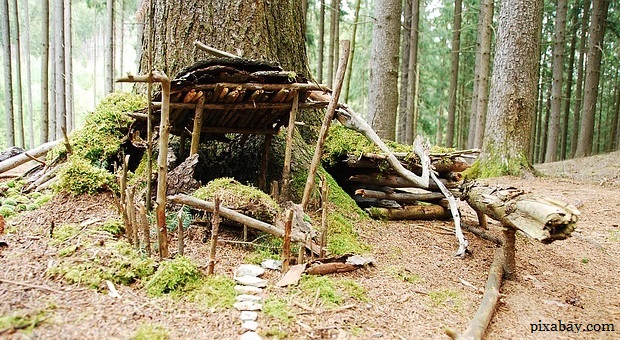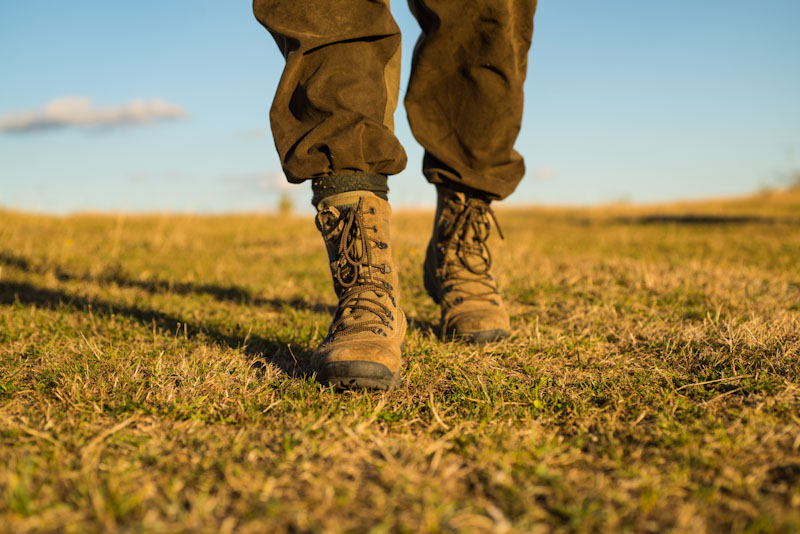Access to a stocked survival shelter means the difference between life and death in an emergency. Unfortunately, your safe spot is only as good as its security.
If that’s compromised, escape is your only option. Here’s how to escape a compromised shelter and the backup plans you should have in place if you need to run.
Know All Your Possible Escape Routes
You must know all your possible escape routes before you need to get out of there. This might include anything from game trails through the woods to roads, highways, and even local waterways. Sewers might sound gross, but they can serve as underground passageways to different parts of the city.
Spend some time exploring your surroundings. You don’t need to know every inch of your property, but the more familiar you are with your setting, the easier it becomes to disappear into the wilderness if needed. Look for caves, fallen logs, hollow tree trunks, and shrubs that could provide a hiding place during your escape.
Be Ready to Run
You might have some warning that you’ll need to escape, but it’s just as likely you’ll need to disappear quickly. Knowing how to escape your survival shelter doesn’t help if you aren’t ready to run at a moment’s notice.
Make sure you have a bug-out bag ready that you can throw over your shoulder. It should include provisions, weapons, and other survival supplies you’ll need to keep going even if you can’t return to your base of operations. Make sure anything you can’t live without — such as vital paperwork or items with sentimental importance — are either kept in your bag or stored in such a way that you can grab them on your way out the door.
Remember to eat enough food and get enough physical activity. You need to be able to run away if you must. If your car doesn’t start or your bike tire is flat, you’ll have no other choice but to escape on foot. Thus, maintaining your strength and stamina is important.
Escape by Land
In most cases, your escape routes will be overland. But this leaves many opportunities for variables you’ll need to consider. Will you be taking game trails, back roads, highways, or some combination? Will you be on foot, in a vehicle, or on horseback? Will you be alone, or will you be bringing your family with you? Are you planning to hide out in the woods and return later, or will you be abandoning the shelter and seeking a new one?
How To Build a Small Bunker in Your Backyard with $400
This is where exploring your property and all your possible escape routes come in handy. You’ll have a plan for where you’ll go if something goes wrong, and you’ll also have backups for your primary escape route.
Escape by Water
Lakes or rivers on your property can also provide a useful escape route. It will be impossible for your attackers to follow if you only have one boat. If more than one boat, it will take you a few minutes to drag any other craft you have at your dock.
It’s also a good idea to have your watercraft stocked with survival and first-aid gear. This is especially useful if you plan to live on your boat for a while.
If you are crossing a lake, you should stash a vehicle on the far side as part of your evacuation plan.
Managing Survival After Escape
Unless you have a backup shelter, you’ll need to survive in the wilderness until you can build a new one or return home. The supplies you bring with you should allow you to do that. Include nonperishable foods, water, and water purification supplies, tools for building shelters and fire, hunting equipment, and general survival items.
Practice your survival skills long before you need them. Building a fire and a makeshift shelter might seem simple, but in an actual crisis, you might find them a bit more difficult—practice in both ideal and challenging conditions. Building a fire with dry wood is easy while making one with snow-soaked kindling or drenched timber is another thing.
Knowing how to find and purify water, navigate and read a compass, hunt and forage for food, and cook over a fire are also essential skills you’ll need to survive. Practice these as well and research edible plants and bugs in your area. You don’t want to die by ingesting a poisonous mushroom.
Return or Abandon
Once you’ve escaped, you need to make a decision. Do you want to wait it out until you can return to your shelter, or do you want to abandon it and start over? In a true survival situation, the latter may be difficult but not impossible.
If you’re planning to abandon ship, you may even consider destroying whatever you leave behind to prevent others from using it. It might sound extreme, but if you’re worried about attackers following you to your next survival shelter, it’s a great way to discourage them from tailing you. Remember to grab all the food and water you can carry before burning the place to the ground.
Consider your surroundings, as well. How far will you need to travel to reach safety? What kinds of wild animals, terrain, and natural obstacles stand in your way? If you plan to climb mountains, cross rivers, or even a desert to find another shelter, you must prepare yourself for these various challenges. The more prepared you are, the more likely you are to survive.
On the other hand, if you plan to return, you must find a safe place to hide and survey the area. Make sure whoever is after you vacate the premises before heading back inside your shelter. Otherwise, you could run into trouble.
In an emergency, staying calm is the key to survival. It’s hard to know what you’ll do or how you’ll respond, but you can prepare for all sorts of scenarios. Be ready for everything, and you’ll never be surprised by anything.












CHRISTIE WAGNER | February 4, 2021
|
This is not a “simple” guide. For example, “stashing” a vehicle on the other side of a lake is near ludicrous. #1 You need to keep the car in operable condition, otherwise the battery will discharge, the tires will become deflated, etc. And how many people have the money to buy such an extra vehicle? Second, if you’re being followed and you use a gun to shoot your food prey, you will be heard. So a bow and arrow would be the reasonable method to hunt your food. How many people are proficient with a bow and arrow? There are many other deficiencies this article has so I am inclined to think that author Martin Banks is living vicariously in writing about the outdoors and survival.: a SECRET LIFE OF WALTER MITTY guy. He seems to be a wannabe, never-has-been and probably a never=-will-be survivalist. Knowing a lot of authentic survivalists,–guys who can shoot, use a bow and arrow, kill prey with a knife, and get lost in the wilderness without ever being found–I would never trust the advice of someone like Martin Banks. And take a look at his photo: his arms look like that of a 12-year-old girl, and not even a remotely athletic 12-year-old girl at that. Does he look like a true, practicing survivalist to you? I’m a chick but I bet I could outdo Mr. Banks in any athletic endeavor. Please vet your authors henceforth as it denigrates your credibility.
Alan | February 5, 2021
|
Christie, Survival is more of a mindset and lifestyle then how someone looks. There are many body builders that would be lost in a TEOTEAWKI scenario and many grandmothers who will prevail. Comments about the article’s content may be valid, but one should not judge a book by its cover.
Minimimo | February 20, 2021
|
Great reply Alan ! Most ww2 vets looked skinny compared to today
The Truth | May 23, 2021
|
I found this article funny! Stand your ground no reason to run. You run you die! Simple. There is no going back as after they use up and take all your stuff they will burn it down! Then you have so many days left … and slowly die so best to just face the facts and fight!!!!! Take them down too …. Why are you running and they are not??? C’mon ….. thi9s article is like fantasy dream land … yet does not offer the reality of the real life scenario! Yes Christie you are correct and more ….. who the hell wants to just survive????? And for what and for how long ….? Take a stance and fight and when you win you get to stay! Hey isn’t that a concept! If people are getting overwhelmed that badly, tomahawk missiles are hitting their house or a tank and full divisions are hitting them … then yes you have a problem. But even if you run how far and for how long will you REALLY Survive and for why? To live in a F#cked up world? If you run and plan to come back and fight … awesome. But to hide and just try to exist is not going to go to far ….
BABS SMITH | October 3, 2021
|
I sure wish this site was printer-friendly!
MikeyW | November 18, 2021
|
Did you miss the icon at the end of the article to download a pdf of it?
Lynne Clark | July 24, 2024
|
The problem with using a PDF is you only get the article, not the comments. These often include valuable information.
I use the “Highlight-Copy-Paste” method. Yes, you will have some editing to do and getting rid of any ads. But you get the comments and any articles that you might also find interesting. I’m not sure the PDF would include that.
Lynne Clark | July 24, 2024
|
I use the “Highlight-Copy-Paste” for all articles I want to keep. You will have some editing to do, but you get the comments which often contain valuable information. You can also set the font you want and the size. As well as eliminating any extra lines.
Some articles I’ve pasted are reduced by 1/2 to 2/3’s by the time I am through.
Louise Welch | November 18, 2021
|
I’m not In shape, either, but I can run if I have to. You should have seen me run up a set of steps when a little three year old pulled down a shelving unit!!! Despite my age I can push a shopping cart with $113 dollars of food in it, 6-8 blocks. Can most of you do that? I’m sure I could chop some wood if I had to. I could at least gather dry wood from the ground in an emergency. I can definitely cook up a storm from ingredients.
Skip | November 20, 2021
|
Your wannabe Rambo, Billy Bad-Ass mentality is going to get you killed, The Truth. Which is just as well, I suppose. Have you ever heard the saying, “He who fights and runs away, lives to fight another day?”
Fredrick D. Reid | February 6, 2022
|
Almost every one has a valid point reference this story. After a 20 yr career (school-trained 95B MP, Cook, Supply and ‘all OTHER duties assigned), Army SOLDIER (RVN vet; 71-72-1st Cab. Div), state-certified LEO (State of KS), then 20+ yrs in Education (SPED classroom Para.), two marriages, five kids (ONE girl; equalevent of 2 MORE boys), four boys, I’ve DEFINITELY learn NOT to ‘judge a book by its cover (sometime s learning NOT to do that the ‘hard’ way.
Phil Rasmussen | January 12, 2023
|
I think that many missed the point of this article. It is about your survival shelter, not home but a place you had set up after having to abandon your home. If for some reason you are in a survival shelter, out in the “wilderness,” you need to have a “bug-out ” plan and the same for each subsequent shelter.
Take for example those people who bugged out to a stadium after Katina. They had no plan to take it further. The goal of bugging out is to get to safety and to re-establish your life after some disaster. Your plan may be general in nature or lock-stepped (DON’T BE SO LOCKED INTO YOUR PLAN THAT YOU CANNOT CHANGE) Many of those who ended up in the stadium had no initial plan or any followup plan. That is dangerous in all ways.
Banks made some valid points. You may not agree and that is ok. As people say about government decision “one size does not fit all.” The point is that YOU must develop YOUR own plan. Take what you can from other plans but remember it is YOUR survival that you are concerned with, NOT theirs.
lamottecreek | October 15, 2023
|
when you are force out you make the rules any thing goes make them think you are hurt sit up a ambush but fine a way out it and hope it slows them down try another ambush then get the hell away if they are still after you gut shoot a couple of them any thing to slow them down maybe even kill them it will make them think it could have been me try to setup up hill then you have a chance to see them use any means to kill them you should have been making a few bombs after shtf very simple just use your head before all hell breaks out thibk of all the movies you have seen any thing goes kill as many as you can before they get you that is my plan at 82 you do not a very good chance to make it i just hope take uome of them with me AIRBORNE all the way and good hunting
Clay | October 16, 2023
|
You make a plan. Then you make 3 realistic back-up plans that are workable. Then you do dry-runs of all those plans to iron out the problems you encounter.
If bad people are chasing you there may be a time when you need to discourage them with surprise force from a hidden position. Setting those positions up ahead of time as well as multiple escape avenues is very important.
Doing all this requires time, which is not going to be realistic AFTER you have to bug out. It is very important to make your working plans now. Dedicate 2 hours this week to actually writing out your plans. Within the next week dedicate 3 hours to actually walking too and through your planned locations. Make notes of problems you didnt think of at first so that you solve them. Pick places nearby each location to place pre-stashed and cached items. Hint-A small cheap camo-colored tarp and twine or paracord wrapped in a garbage bag and buried nearby each escape location could be a life-saver in an emergency.
I guarantee you procrastination will be the downfall of most people in an emergency. Many will buy a few items to have on hand but that is as far as their preps go. Do not be one of those people. Start working on this now. There is no downside to actually walking through your main plan and your back-up plans.
Ja | January 8, 2024
|
So what if we have our property set up to try to stay.?What absolutes would have us leave? No one seems to go there. The decision is not always to bug out.
radar | April 21, 2024
|
Martin says, “If you’re planning to abandon ship, you may even consider destroying whatever you leave behind to prevent others from using it. It might sound extreme, but if you’re worried about attackers following you to your next survival shelter, it’s a great way to discourage them from tailing you. Remember to grab all the food and water you can carry before burning the place to the ground.
I absolutely disagree with these suggestions. First, if they take what I left, it will slow them down. If I start it on fire, they won’t be discouraged, they will be angry and chase me and they will definitely torture me before killing me. At my age, easily outrun; anything that may slow down those following me is a benefit to me, because of age, and because depending upon terrain I would be easy to track.
Martin’s comment now gives me a new Idea. I should put into my survival shelter that I may have to flee from about six pints of alcohol, so that a group of up to six can “have a party” in the shelter first and forget altogether about me. While they are partying they may even “toast me”, in the sense of offering compliment to “the forward thinking stranger who offered them a pleasant “opportunity found!’ Who knows, maybe I will run into them again–I can ask them how they liked what I left them. If they are already happy with me, I can offer myself as a “slave” and maybe save my life. It is also possible that while they are partying that they will fight and injure themselves, or get tired and sleep. Either way, it would be a cheap “win” for me. But burning down a BO shelter is a loss to me; getting quickly caught and killed for doing it is a loss to my family (I won’t be much good for them, if I am dead). In the Revolutionary/Civil Wars where people did this (says the “movies”), the farmers were trying to protect their seed in the ground and the crop it could grow, even if the cabin was ashes. In a Bug Out, I will likely not have much of a garden to protect. Running away fast (even with back-up plans) is very hazardous–what if the wind is blowing in the direction I am running–and I started the fire before I realized what I was doing in my rush?
persona non grata | July 22, 2024
|
leave them some homebrew with all the methanol left in
radar | July 23, 2024
|
Interesting comment: PNG. I’ve read that alcohol stills can make up to 85% (equivalent to 170 proof) ethanol [and not methanol] by repeated brewing (adding more sugar and brewing it again and up to 3 times to increase its concentration); such as on farms for ethanol fuel for ethanol engines. So I bought a 5th (it was $12.00 cheap) of EVERCLEAR–190 proof (so it is 80% ethanol alcohol). And, no-no-no, would I ever drink this stuff! And, since I am old (so I could be feeble without knowing it) the Liquor Store people told me, “Don’t ever try to drink this stuff straight”—it is poison, it will burn and scar all your body tubes” (and I already knew that). I bought it because I live in a 4-season “regularly very humid and wet State”. So, I thought that if I have to have a fire, and if my fingers are already numb with cold; and so cold that I couldn’t even light a paper match—I have to have a way to get a fire going FAST; and so I chose EverClear to be that way (though I have never tried that)–and I am aware that Cache Valley Prepper has an equally fast fire-start way far safer (it is a dry product that burns instantly), but I have never bought that product, so I am not familiar with it.
And as I write this, I am thinking about Martin’s suggestion to burn down—as if to slow down—possible pursuers. So, I am thinking, NO, don’t burn it down; instead get them drunk as a skunk on a diluted Everclear! Besides, it is a great fire-starter; and there is no question at all that it is a disinfectant (though it could also burn badly skin if not diluted). So, I bought it on the basis that it is cheap ($12), and better to have, than to have NOT. That is all I am saying!
But I have been out in the woods at night, so cold, my fingers went numb; and I had trouble starting a fire with paper matches—they didn’t work because I couldn’t feel my fingers; and I was not mentally prepared for such an event. It was an eye-opener for me. But I am still “thinking about” the concept of burning down one’s BO shelter because Bad Boys are coming my way; and I am an old guy, . Yes, I knew when my fingers went numb that I could RUN and re-warm my fingers with my own calories. But in a forest on a cloudy night when you can’t see what is ahead of you, running is not a great survival idea! Plus I could get lost, or fall and impale myself. SO I PICKED A HACK (in current time) that would definitely light up a fire, even if it also burned out quickly because of the wet conditions and at the “wrong time”, when it was too dark to see and I was miserably wet with numb fingers. I chose EverClear to be my hedge, mostly because it is sold in a glass bottle with a plastic cap—I have lots of those, and small ones easy to carry. I also carry bees-wax candles with me—but they do require a match to light them; and I had trouble lighting dry kindling. I was naïve and not prepared for that experience. I am remembering something from 30+ years ago, when I was not a prepper; and it sort of still haunts me!